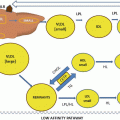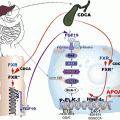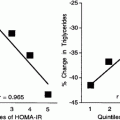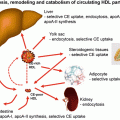Trial name
No. of patients
No. of patients with DM
Changes in lipids in treatment group compared to control
Outcome
Niacin
Placebo
Niacin
Placebo
TC
TGs
LDL-C
HDL-C
Coronary Drug project (1975)
1,119
2,789
(5.2 %); insulin users excluded
↓10
↓26
NR
NR
All-cause mortality: 24.8 % vs. 25.9 %, p = NS
Nonfatal MI: 10.7 % vs. 14.8 %, p = 0001
Stockholm (1988)
279
276
3.0 %
3.6 %
↓13
↓19
NR
NR
Mortality decreased 26.6 %
CV death dec 36 %
Serum cholesterol decreased 13 %
Serum Trig dec 19 %
FATS (1990)
48
52
Excluded patients with diabetes
↓23
↓29
↓32
↑43
↓80% clinical events (<0.01)
Significant angiographic regression
CLAS (1987)
80
82
Excluded patients with diabetes
↓26
↓22
↓43
↑37
Significantly less angiographic progression
No difference in clinical events
HATS (2001)
73
73
16 %; uncontrolled diabetes excluded
↓29
↓34
↓48
↑18
↓60% clinical events (p < 0.02) in simvastatin–niacin
Significant angiographic regression
ARBITER-2 (2004)
87
80
22
24
NC
↓13
↓2
↑21
No significant difference of CIMT
ARIBITER-6 (2009)a
97
111
31
44
↓6
↓16
↓12
↑18
Mean CIMT significantly reduced
MACE: 1 % vs. 5 %, p = 0.04
AIM-HIGH (2011)
1,718
1,696
588
570
NR
↓26
↓16
↑20
No difference in MACE
HPS2-THRIVE
25,673
7,000+
Expected 2013
Coronary Drug Project
This landmark and pioneering study sponsored by the US National Heart Lung and Blood Institute (NHLBI) evaluated the mortality benefits of four different therapies in male survivors of MI. The trial is also notable for being the only trial to ever have evaluated the cardiovascular outcomes of niacin as monotherapy. Eleven years after Altschul’s seminal publication, the CDP group randomized 8,341 men with a history of MI, including type 2 diabetes, to one of six treatment groups: conjugated estrogen (high or lose dose), dextrothyroxine sodium, clofibrate (1.8 g/day), niacin IR (3 g/day), or lactose placebo. The trial began enrollment in March 1966 and randomized the last patient in October 1969. Follow-up data was censored in February 1975, and 95 % of patients were followed for at least five years.
Although the inclusion criteria targeted a high-risk population for secondary prevention, patients with insulin-dependent diabetes mellitus were specifically excluded. The majority of patients had angina and nearly one-half of the niacin-treated patients had a serum cholesterol >250 mg/dL. Nonetheless, there was still a large group of patients with diabetes or prediabetes, and 5.4 % of patients randomized to niacin were concomitantly treated with oral hypoglycemic medications at enrollment. Nearly 40 % of niacin-treated patients had evidence of abnormal fasting glucose (>100 mg/dL) and/or impaired glucose tolerance (≥180 mg/100 mL) after an oral glucose test.
Among the significant findings of this trial was the excess mortality of patients randomized to either estrogen or dextrothyroxine. Due to the increased risk of death, high-dose estrogen therapy (5.0 mg/day) was discontinued in 1970 and low-dose estrogen (2.5 mg/day) and dextrothyroxine stopped in 1971. Clofibrate, niacin, and placebo groups were continued in the trial as originally planned.
Despite significant reductions in total serum cholesterol and triglycerides, there was no significant difference between the active treatment groups and placebo in terms of the primary end point of all-cause mortality. All-cause mortality in niacin-treated patients was not significantly different compared to placebo (24.4 % vs. 25.4 %). The survival curves for niacin, clofibrate, and placebo were virtually superimposable during the first 68 months of follow-up. An adjusted analysis of all-cause mortality failed to find a benefit of niacin in 5-year mortality either. A subgroup analysis of patients being treated with oral hypoglycemic agents found no significant difference in 5-year mortality between niacin and placebo (32.8 % vs. 32.5 %, Z N = 0.05). Z N values between −1.96 and 1.96 indicate homogeneity or no statistically significant difference between groups (p > 0.05). With regard to lipoprotein effects, the mean total cholesterol decreased by −9.8 % and TG decreased by 26.1 %. These improvements in cholesterol and triglycerides were slightly more robust than with clofibrate. There was no specific HDL-C or LDL-C measurement.
Though the CDP was a negative trial based on the initial analyses, several secondary end points suggested cardiovascular benefit with niacin. The combined end point of CHD death/nonfatal MI was lower in the niacin group, primarily driven by a significantly reduced incidence of nonfatal MI, which was 27 % lower in the niacin group (8.9 % vs. 12.2 %, Z N = −2.88). The niacin group also had a 24 % lower incidence of CVA (8.5 % vs. 11.2 %, Z N = −2.46). This reduction is particularly important given that compared to placebo, a slightly higher incidence of atrial fibrillation (4.7 vs. 2.9, Z N = 2.63) and other arrhythmias (32.7 vs. 28.2 %, Z N = 2.74) was noted in niacin-treated patients.
At 5-year follow-up, measurements of serum glucose demonstrated that niacin did worsen hyperglycemia mildly. Mean fasting glucose increased 8.0 % from baseline in the niacin group vs. 5.0 % in the placebo group (Z N = 2.52). The 5-year incidence of elevated fasting glucose (>120 mg/dL) in niacin-treated patients was also significantly increased compared to placebo: 23.8 % vs. 15.9 % (Z N = 5.23). However, the incidence of glucosuria was not significantly different. At five years, there was no significant difference in the prevalence of insulin or oral hypoglycemic medication use in niacin-treated patients compared to placebo: 4.6 % vs. 5.4 %.
Based on the initial follow-up of CDP results, it was concluded that despite the reduction of total cholesterol and lower morbidity (nonfatal MI’s, fatal/nonfatal CVA) in niacin-treated patients, there was no mortality benefit to niacin treatment. The authors also cautioned against the use of niacin treatment in patients with diabetes.
Coronary Drug Project 15-Year Mortality
Due to the possible excess cancer mortality of patients randomized into the low-dose estrogen group and concerns of clofibrate safety from the World Health Organization Trial, the NHLBI sponsored a long-term follow-up study of all patients who were randomized in the CDP [46]. The primary goal of the study was to determine the vital status of 6,008 patients who were alive at the initial data censure in February 1975. The mean follow-up was 15 years (6.2 years during treatment and 8.8 after termination of the study).
Unexpectedly and discordant with the original CDP trial, the all-cause mortality of the niacin-treated patients was 6.2 % lower than placebo (52.0 % vs. 58.2 %, p = 0.0004). The main difference in overall mortality was a significant reduction of cardiovascular mortality; however, there was a trend towards reduced mortality due to cerebrovascular, cancer, and noncancer causes as well.
The mortality benefit persisted with subgroup analysis by age, serum cholesterol, and serum triglycerides. Importantly, this benefit also was seen in patients with impaired fasting glucose (≥100 mg/dL). The survival curves of niacin and placebo were identical until month 72, when divergence begins. The initial analysis of CDP did note the start of this separation, but there was inadequate follow-up at that time to have statistical significance. The separation of curves continued despite the cessation of niacin treatment. It remains unclear why was there a 6-year delay before niacin treatment manifested a mortality benefit and why did this benefit persisted despite lack of treatment. One possibility is that the progression of atherosclerosis was most effectively altered by niacin. Compared to the other treatment groups, niacin treatment resulted in the greatest reduction in serum cholesterol and triglycerides, −10.1 % and −26.9 %, respectively. The clinical benefit of this was initially manifested by a reduction in nonfatal MI seen in the niacin group starting about 2 years after randomization.
Stockholm Ischemic Heart Disease Secondary Prevention Study
Performed in the “pre-statin” era, this open-label, secondary prevention trial enrolled 554 survivors of MI’s and randomized them to either placebo or combination clofibrate/niacin for five years. The specific form of niacin used was a nicotinic acid ester called pentaerythrityl tetranicotinate or niceritrol, which has delayed release characteristics. Though insulin-dependent diabetic patients were excluded, the trial still enrolled a small cohort of diabetic subjects, 3.6 and 3.0 % in the control and treatment groups, respectively. There were no specific subgroup analyses of outcomes for patients with diabetes [66].
Most notably there was a 26 % reduction of all-cause mortality and a 36 % of CV death in patient’s treatment with clofibrate/niacin vs. placebo (p < 0.01). Patients in the treatment arm were observed to have a significant improvement in their lipid profile: serum triglycerides were reduced by 19 % and serum cholesterol decreased by 13 % (p < 0.001 for both end points). HDL-C was not reported. Interestingly, the authors concluded that the CV mortality benefit correlated with reduction in serum triglycerides rather than serum cholesterol.
Cholesterol-Lowering Atherosclerosis Study
This relatively small angiographic study was a randomized, placebo-controlled, selectively blinded trial which randomized 162 male post-CABG patients to either 30 g of colestipol hydrochloride plus niacin (titrated to 3–12 g/day) or placebo. Patients with diabetes, hypertension, or hypertriglyceridemia (>500 mg/dL) were excluded from the trial. The trial was designed to evaluate the change of coronary or peripheral arterial stenosis after two years of treatment using a semiquantitative measurement called the “Global Change Score.” Based on this assessment, overall progression of disease was significantly reduced with colestipol–niacin treatment. Importantly, the lipid profile significantly improved in colestipol–niacin-treated patients compared to placebo: LDL-C levels decreased −43 % vs. −5 % (p < 0.001), HDL-C increased 37 % vs. 2 % (p < 0.001), and total cholesterol decreased −26 % vs. −4 % (p < 0.001) [67].
Familial Atherosclerosis Treatment Study
This small, randomized, doubled trial assessed the change in the severity of proximal coronary artery disease assessed by a semiquantitative analysis [68]. The trial population consisted of 146 men with angiographically proven CAD, as well as elevated ApoB levels (>125 mg/dL) and family history of CAD. Diabetic subjects were excluded from the trial. Participants were randomized to one of three treatment groups for 2½ years: lovastatin (20 mg twice a day) plus colestipol (10 g three times a day), niacin (1 g four times a day) plus colestipol (10 g three times a day), or conventional treatment (diet counseling and “placebo”). However, as per protocol, subjects could receive colestipol if LDL-C was above the 90th percentile for age. Thus, 43 % of patients in the placebo group received colestipol.
Participants underwent a baseline coronary angiogram and a 2½ year follow-up. In the conventional treatment group, 46 % had progression of at least one lesion at one of nine proximal coronary artery segments. By comparison, the incidence of progression of proximal stenosis was approximately half that observed in the conventional treatment group, 23 % (p = 0.005). Since the trial was relatively small, there were few clinical events observed. However, the primary clinical composite end point (CV death, MI, or revascularization for worsening ischemic) was observed significantly more in the placebo group than in the active treatment group (11 vs. 5, p = 0.01). In the conventional treatment group, LDL-C and HDL changed modestly: −7 % and +5 %, respectively. In contrast, the lipid profile was significantly improved in the niacin–colestipol group: LDL-C decreased 32 % and HDL-C increased 43 % (p < 0.001). ApoB levels significantly decreased with both lovastatin–colestipol and niacin–colestipol treatment: −35 % and −28 %, respectively (p < 0.001).
A few side effects were noted. Two patients in the niacin–colestipol group had to receive antidiabetic medications, and two other patients developed gout. Mean AST increased by about 20 % in both niacin–colestipol and lovastatin–colestipol groups, but no individual patient developed significant AST elevation greater than three times normal.
Multivariate stepwise analysis of mean change in proximal stenosis found %∆ HDL-C and %∆LDL-C as independently predictive. Other variables also independently predictive were ST-segment depression at peak exercise during baseline treadmill stress testing, %∆ ApoB, and %∆ systolic blood pressure during treatment. These results of Familial Atherosclerosis Treatment Study (FATS) suggested that significant improvements in CAD, assessed by angiographic and clinically metrics, could be observed with therapies that effectively raised HDL-C and lowered LDL-C.
HDL-Atherosclerosis Treatment Study
This was a randomized, double-blind, placebo-controlled angiographic trial that used a two-by-two factorial design to evaluate the effects of combination simvastatin–niacin therapy and/or antioxidant therapy (vitamin E, C, β-carotene, and selenium) vs. placebo [69]. The primary end point was the mean change of stenosis caused by the most severe lesion in a proximal coronary artery segment using quantitative coronary angiography (QCA). The pre-specified primary clinical end point was the time to occurrence of cardiovascular death, non-fatal MI, CVA, or revascularization due to worsening ischemia.
The study population consisted of 160 patients; 55 % had prior MI and 49 % had undergone prior angioplasty. Sixteen percent had diabetes mellitus, although uncontrolled diabetic subjects were excluded from the trial. The patients were randomized to one of four groups: placebo (n = 44), simvastatin–niacin (n = 33), antioxidant vitamins (n = 39), or simvastatin–niacin plus antioxidants (n = 40). Of note, in an effort to maintain blinding, the placebo group received a small dose of immediate-release niacin (50 mg twice daily) to provoke flushing. Simvastatin–niacin-treated patients experienced a 42 % reduction of LDL-C and a 26 % increase in HDL-C levels. The addition of antioxidants to simvastatin–niacin blunted both the lipid-lowering effects and the capacity to raise HDL-C of simvastatin–niacin [70]. Coronary artery disease as measured by angiography worsened in patients assigned to placebo but regressed in the simvastatin–niacin group (p < 0.001) [69].
Atherothrombosis Intervention in Metabolic Syndrome with Low HDL/High Triglycerides: Impact on Global Health Outcomes (AIM-HIGH)
Despite aggressive pharmacologic therapies to reduce LDL-C to target levels, a large proportion of patients with CAD will continue to have CV events. In these patients, HDL-C levels have independent prognostic value. The AIM-HIGH investigators hoped to demonstrate that HDL-C raising and triglyceride lowering with Niaspan ER after aggressive LDL-C lowering with statins and ezetimibe (for some of the patients) would improve cardiovascular outcomes in patients with stable coronary artery disease [71, 72].
AIM-HIGH enrolled patients age 45 years or older who had established cardiovascular disease, defined as documented stable CAD, cerebrovascular disease, carotid artery disease, or peripheral arterial disease. At entry, patients had low baseline levels of HDL-C (<40 mg/dL for men, <50 mg/dL for women). LDL-C levels were required to be lower than 180 mg/dL. Compared to the placebo, the baseline mean LDL-C (mg/dL) was not significantly different in patients randomized to ERN plus simvastatin: 75.8 ± 24.3 vs. 76.2 ± 25.7, respectively. Mean HLD-C was nominally higher in the placebo group: 35.3 ± 5.9 vs. 34.8 ± 5.9 (p = 0.04). The trial was multicenter and enrolled patients from the USA and Canada.
The trial’s primary end point was the composite of CV death, nonfatal MI, ischemic CVA, hospitalization for an ACS, or cerebral revascularization. It was an event-driven trial expected to have 800 adjudicated events with a mean follow-up period of 4.6 years. The trial was proposed to have 85 % power to detect a 25 % relative risk reduction in the primary end point.
A total of 3,414 patients were randomized to ERN (1,500–2,000 mg/day) plus simvastatin or placebo plus simvastatin. It must be noted that the placebo group (like other trials) received niacin IR (50–100 mg twice a day) to mask treatment. Simvastatin was adjusted based upon a prespecified algorithm to maintain LDL in the range of 40–80 mg/dL. In addition, subjects in either group could receive an adjunctive daily dose of ezetimibe 10 mg/day to achieve the target LDL-C level of 70 mg/dL.
Patients with diabetes were included in the trial and were one of the six prespecified subgroups for analysis. Of subjects with a history of diabetes, 570 (33.6 %) were randomized to placebo plus simvastatin and 588 (34.2 %) were randomized to ERN plus simvastatin. The mean baseline HbA1c was similar: 6.68 ± 0.85 % and 6.70 ± 0.88, respectively. There was no significant difference in mean baseline glucose or serum insulin either.
AIM-HIGH was stopped early by the Data Safety Monitoring Board (DSMB) due to lack of efficacy and a trend towards a higher rate of ischemic strokes in the ERN-treated group: 556 patients had a primary end point event (282 [6.4 %] in the niacin group and 274 [16.2 %] in the placebo group, HR 1.02; p = 0.80). There was a trend towards a higher incidence of ischemic strokes in the niacin group: 27 patients (1.6 %) vs. 15 (0.9 %) and hazard ratio (HR) 1.61; p = 0.11. In subgroup analysis no benefit for niacin could be detected among subjects with diabetes.
The trial’s results were very controversial and received considerable attention regarding its design, early termination, and negative findings. It was criticized for being underpowered to detect a clinical benefit since the between group difference of HDL-C was only 4 mg/dL. This resulted from a higher than expected increase in the HDL-C in the placebo group, which did receive a small dose of immediate-release niacin.
Other critiques focused on the possible differential effects of niacin on total cholesterol (HDL-C or LDL-C) vs. modulation of particle size (HDL-P or LDL-P). Niacin can cause discordant effects on total measured cholesterol (HDL-C or LDL-C) and particle size/number [73]. While combination therapy of ERN and simvastatin compared to atorvastatin monotherapy has been shown to favorably increase the number and size of HDL particle subclasses, the effect of ERN and simvastatin in the AIM-HIGH trial is still unknown pending results of the nuclear magnetic resonance substudy [74]. Thus, if Apo B or LDL-P levels have been lowered to very low values, then raising HDL-C without accompanying changes in HDL-P offers no additional incremental CV risk reduction benefit [75, 76].
The Treatment of HDL to Reduce the Incidence of Vascular Events (HPS2-THRIVE)
The ongoing HPS2-THRIVE trial is by far the largest trial to evaluate the clinical benefits of niacin treatment (Clinicaltrials.gov: NCT0046-1630). This trial is a multicenter, randomized, double-blind, placebo-controlled trial which enrolled over 25,000 patients with CAD, cerebrovascular disease, peripheral arterial disease, and diabetes from the UK, Scandinavia, and China. More patients have been enrolled in this single trial than all previous randomized niacin trials combined. Furthermore, HPS2-THRIVE will enroll more than 7,000 patients with diabetes which will finally allow for a robust understanding of the beneficial or potentially deleterious effects of niacin in people with diabetes. The study is headed by the Clinical Trial Service Unit of the University of Oxford. The goal of the study is to evaluate the clinical benefits of adjunctive treatment with extended-release niacin 1 g/laropiprant (ERN/LPRT) in patients already treated with simvastatin 40 mg/day ± ezetimibe. ERN/LPRT (Tredaptive®; Merck & Co, Inc) was approved for use in the EU in 2008, but is not yet approved for use in the USA. LPRT is a selective prostaglandin D receptor antagonist that significantly reduces the frequency and intensity of niacin-induced flushing [77]. The primary end point will be time to first major vascular event: nonfatal MI, CV death, CVA, or revascularization. Patients will be followed for a mean of at least 4 years. Enrollment in HPS2-THRIVE was completed in June 2010, and preliminary results are anticipated in 2013.
Stay updated, free articles. Join our Telegram channel

Full access? Get Clinical Tree








